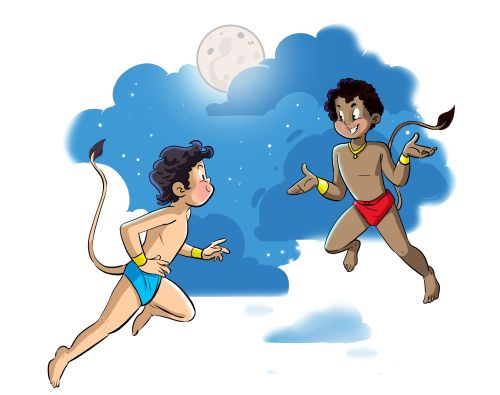The story so far: Hanuman learns about gravity, air pressure, temperature and density and that air pressure, density and temperature decrease when gravity decreases.
Hanuman: Friends, I have a nagging doubt.
Air molecules: What about, Hanuman?
Hanuman: Earth’s gravity is what is pulling us all towards it and keeping us from falling off, right?
Air molecules: Absolutely. It’s what Sir Isaac Newton deduced when the apple fell from the tree.
Hanuman: Then why isn’t the Moon not being pulled towards Earth?
Air molecules: Ummm…Maybe it is because it escaped Earth’s gravitational pull…
Hanuman: Can’t be! If that’s the case, then the Moon wouldn’t be revolving around Earth.
Air molecules: Hmmm…Wait! We know someone who may know the answer.
Hanuman: Who is it?
Air molecules: Nala, son of Viswakarma, the divine architect. He is very smart and has a good knowledge of physics.
So the air molecules and Hanuman visit Nala, who is surprised to see them flying towards his house.

(Illustration: Sahil Upalekar)
Nala: Welcome, Hanuman!
Hanuman: How do you know me, Nala?! You are a vanara (half-man half-ape) as well?
Nala: Yes, I am a vanara. And who doesn’t know you? You are famous! So, what brings you here?
Hanuman: I have a doubt, which my friends say you can help clarify.
Nala: What is it?
Hanuman: How come the Moon is not affected by Earth’s gravity?
Nala: It is. But it does not move towards Earth because of Angular Velocity.
Hanuman: What’s that??
Nala: Let me explain how Newton figured it out.
Hanuman: Newton, again! Fine…
Nala: Newton had the same doubt — how come the Moon, which weighs 7.3 x 10^22 kg, is not falling towards Earth? He had no one to help, so he started finding answers using his thought experiment.
Hanuman: What does ‘thought experiment’ mean?
Nala: It means to try and find answers by imagining a scenario. In this case, it famously came to be known as Newton’s cannon ball experiment.
Hanuman: What does the Moon have to do with a cannon?
Nala: Imagine that you are standing on top of Mount Meru and shoot a cannon ball horizontally at a very low speed. What will happen?
Hanuman: It may fall very close to the cannon.
Nala: Exactly. It will follow a horizontal path at the start and then eventually drop because of gravity. What will happen if you increase the speed?
Hanuman: It may fall a little farther.
Nala: Yes, it will take a longer path. As you keep increasing the speed, the cannon ball may travel a longer distance but it will eventually fall down. Now tell me, Hanuman, what will be the shape of the ball’s path?
Hanuman: A straight line?
Nala: No, it will be a curve. Air molecules, please throw some seeds into the air to demonstrate.
The air molecules throw some seeds, which follow a curved path.
Nala: As you keep increasing the speed, the projectile — anything thrown using applied force can be called a projectile — takes a bigger curvature. At one point, it will start to match the curvature of Earth.
Hanuman: How?
Nala: What is the shape of Earth?
Hanuman: A sphere
Nala: If you keep increasing the projectile’s speed, it will start to travel far and, at the same time, be pulled down by Earth’s gravity. At some point, its speed and the pull of gravity will match so that the projectile will continue to fall without touching the ground and thus complete a full circle around Earth.
Hanuman: Gravity is very low at 3,84,000 km — the distance of the Moon from Earth — and friction is also less because there are no air molecules, making it a vacuum-like environment. So it never losses its speed.
Nala: Yes. And this cycle just goes on for millions of years. This is what we call as its orbit. Eventually, there will be small changes in the orbit. Our Moon is moving away from Earth at about 3.8cm per year but other planets’ Moons may either move away or closer and crash into them.
Hanuman: But you still haven’t told me what angular velocity is.
Nala: Oh yes. Speed with direction is velocity. Velocity with a certain angle is angular velocity.
Hanuman: So this is what keeps moon circling around Earth.
Nala: Orbiting.
Hanuman: All right! Orbiting! Are you always this geeky?
Nala: Ha ha! Yes, since my birth.
Hanuman: Can we be friends?
Nala: Of course!
Hanuman (sarcastically): I need some smart friends too.
Air molecules (cheekily): In that case, you can fly yourself home without our help.
Hanuman: Hey, no! I was just kidding!
Air molecules (laughing): So were we!
The author is the founder and CEO of Vaayusastra Aerospace, an IIT-Madras incubated ed-tech startup that offers Air Science workshops for children between five and 14 years.
********
Below is an illustration of how and why the moon orbits around Earth. Based on your reading of the conversation between Hanuman and Nala, can you drag and drop the labels into the correct boxes?











